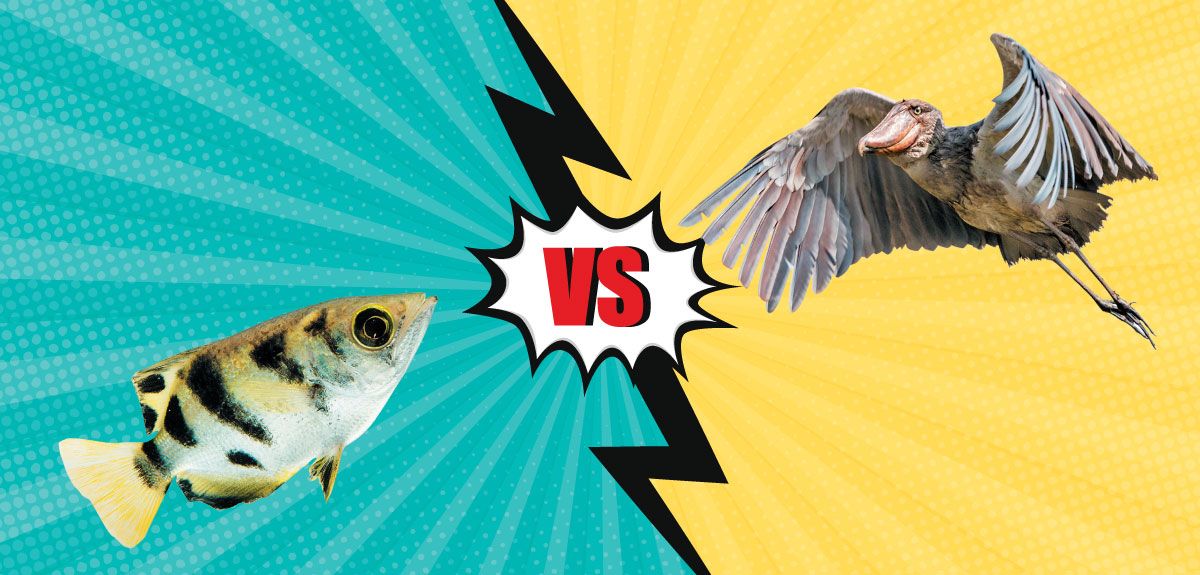Birds vs. fishes

Credit: C&EN/Shutterstock
Battle of the beasts: Scientists take to Twitter for #TeamFish versus #TeamBird.
Bird watchers and fish fanatics have taken to Twitter to fight about the superiority of their chosen vertebrate. The hashtags #TeamBird and #TeamFish began trending after the inaugural #BlackBirdersWeek in June 2020. A social media movement founded by Black scientists and bird watchers, #BlackBirdersWeek put a spotlight on the racism that Black nature enthusiasts face in public spaces. While the two teams are united against systemic racism, they’re using the social media platform to duke it out over their lack of respect for the other’s favorite animals.
Kory Evans, an evolutionary biologist and ichthyologist at Rice University, is a vocal proponent of #TeamFish. “Almost anything that birds can do, fish can do better,” Evans tells Newscripts. “Except flight. Fishes aren’t great at that,” he adds. #TeamBird counters with the humble duck. Deja Perkins, an urban bird ecologist and coorganizer of #BlackBirdersWeek, says ducks—which can walk, swim, and fly—are highly familiar even to non–bird watchers. Ducks are a great example of how birds are everywhere around us, even in urban environments, according to Perkins.
Even though birds are easier to observe, Evans insists that fish are just as colorful and fun to watch. “Fish are tragically underrated in how beautiful they are, and they have complex social behaviors,” Evans says. Some fish even use tools: for example, archer fish shoot insects out of the air with a jet of water from their mouths.
But #TeamBird has a favorite trump card in their fight for superiority: “Birds are living dinosaurs,” Perkins tells Newscripts. “Look at the shoebill. That bird looks like a dinosaur, and it’s terrifying.”
“As an evolutionary biologist, I have to honor that,” Evans concedes. But fish are the ancestors of all living vertebrates, and by that logic “a lot of times people just collapse the whole argument by saying birds are actually fish,” Evans says.
Though the teams may bicker on Twitter, the ultimate goal of movements like #BlackBirdersWeek is to make nature a more inclusive space for everyone by bringing awareness to the discrimination that prevents women and people of color from feeling safe outdoors. “No matter if you’re #TeamBird or #TeamFish,” Perkins says, “as long as you’re outside observing nature, I think that’s what’s important.”
Brittle star rocks its debut

Credit: Markus Felix
Rock stars: A new brittle star fossil is named for rock musician Floor Jansen of Nightwish.
For Ben Thuy, a paleontologist at the National Museum of Natural History of Luxembourg, rock music and fossils go hand in hand. Thuy is part of a team that characterized the fossils of a newly discovered species of brittle star that lived at the end of the Cretaceous period (PeerJ 2020, DOI: 10.7717/peerj.9671). The ancient brittle star resembled its living relatives: it looks like a Halloween-themed starfish with five spiky, spindly legs that it used to catch food that floated by. While dinosaurs were still walking the earth, the little brittle star—only 6 cm across—clung to sea lilies in the shallow waters of what is now the Netherlands.
When it came time to name the species, Thuy and his collaborators immediately thought of their favorite Dutch vocalist: Floor Jansen, lead singer of Nightwish. Thus, Thuy says, the official species name, Ophiomitrella floorae,“combines our passion for fossils and rock music.” While that may seem unorthodox, naming fossils for musicians is not uncommon. “I’m guilty of naming a couple of species after my favorite bands,” Thuy tells Newscripts. And his colleagues have done the same. There’s now an entire exhibit, “Rock Fossils on Tour,” featuring more than 70 fossils named for musical artists. While Thuy believes O. floorae will add insight to the evolution of invertebrates, he also hopes that it will get people excited about paleontology. “It’s a name that builds a bridge to another world—in this case the world of music,” he says.
Please send comments and suggestions to newscripts@acs.org.
Chemical & Engineering News
ISSN 0009-2347
Copyright © 2020 American Chemical Society